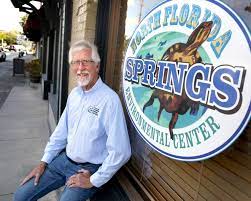By Robert Knight, Howard T. Odum Florida Springs Institute
Kudos to the owners, editors and reporters of the Gainesville Sun and the Ocala Star Banner for renewing their in-depth investigative reporting about the declining conditions at Florida’s springs.
The original Fragile Springs series was published in November 2013 and subsequently was awarded the 2014 Editor & Publisher Eppy Award for Best Community Service reporting. Those articles covered the good, the bad and the ugly of Florida’s 1,000-plus artesian springs and contributed to a better-informed public regarding the importance of abundant, clean and fresh groundwater for all life in North Florida.
In a series of articles, videos and podcasts researched over the past several months, Sun reporter Cindy Swirko and photojournalists Brad McClenny and Alan Youngblood, with guidance from Executive Editor Doug Ray, have updated the Fragile Springs story.
While we enjoy being optimistic, our region’s battered springs and the wildlife they support have continued their steady decline. For readers who might appreciate a synopsis of the continuing Fragile Springs odyssey, I offer the following summary.

The three leading causes of springs’ impaired health continue to be, in order of severity: flow reductions, nitrate pollution and excessive recreation. While all three of these major stressors have relatively easy and inexpensive solutions, Florida’s state and local governments have favored policies that continue to reward and subsidize the guiltiest perpetrators of springs harm.
The long-term trend in declining spring flows statewide is primarily the result of excessive groundwater pumping. No other explanation comes close to explaining the fact that Florida’s springs have lost about one third of their natural flows. The science shows that springs ecological health is harmed by flow reductions of about 5%. No wonder there is visible harm at the majority of Florida’s springs.
The obvious solution to this problem is to reduce groundwater pumping. This can be accomplished by reducing all state-issued groundwater permits, imposing a fee on all groundwater extracted payable to protect springsheds, and an increased reliance on using rainfall for crop and landscape irrigation.
Instead of charging taxpayers for expensive pipes and pumps to move water around in circles, the state could leave the water in the aquifer feeding our natural springs – for no cost.
Not surprisingly, nitrate nitrogen concentrations are still rising in the Floridan Aquifer and in Florida’s artesian springs. These pollution increases are directly tied to the amount of nitrogen applied to the land surface by human activities.
An estimated 40 million pounds of nitrate nitrogen reach the Floridan Aquifer annually in the springs region. Not only does that nitrogen fuel algal blooms that kill native plants and animals in springs, nitrate is acutely and chronically toxic to humans at levels found in areas of intensive agriculture, animal husbandry and septic systems.
Instead of publicly funded Basin Management Action Plans that have limited success, the simple, no-cost solution for taxpayers is to stop subsidizing agricultural and urban development corporations by allowing them to pollute the aquifer. All controllable nitrogen sources must be regulated with a cap on use and a fee per pound of nitrogen. This revenue should be used to protect the aquifer and springs.
Fragile is a good adjective for Florida’s priceless springs. Their plant communities do not respond well to excessive human foot traffic. Springs-dependent wildlife encountering people are often frightened away from the waters they rely on. Outboard motors tear up submerged vegetation. Microplastics are accumulating in spring water, sediments and food chains. Even sunscreen washing off of hundreds of bodies may be harming our springs.
The easy solution is not always popular. But recreational springs must have a carrying capacity that protects them. Like a bull in a china shop, people and their machines should be limited or excluded from some springs. Just limiting parking and roping off the most sensitive areas can make a significant difference in springs health.
For those individuals reading the Sun’s Fragile Springs Revisited, let me offer this thanks and a warning. You are the best hope for a bright springs future. Thank you for caring and for sharing this information with other public-minded citizens. But all of us should heed this warning — a bright springs future is not ensured.
This opinion piece first appeared in the Gainesville Sun.
Robert Knight is the director of the Howard T. Odum Florida Springs Institute in High Springs. He is the author of three springs books, including “Silenced Springs – Moving from Tragedy to Hope” and “Death by a Thousand Cuts – an Anthology of Springs Opinions.” His newest book to be released soon is titled “Saving Florida’s Springs – A Prescription for Springs Health.”
“The Invading Sea” is the opinion arm of the Florida Climate Reporting Network, a collaborative of news organizations across the state focusing on the threats posed by the warming climate.



